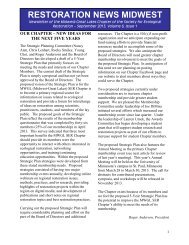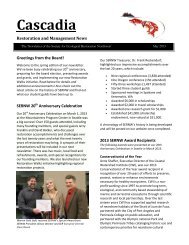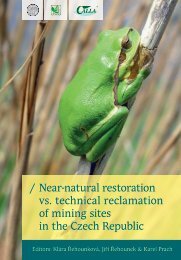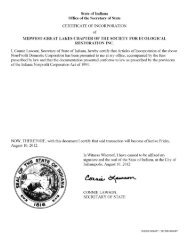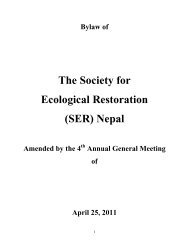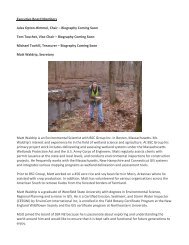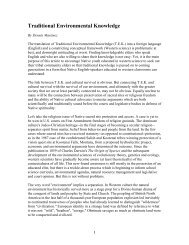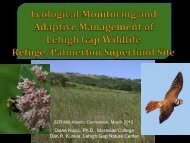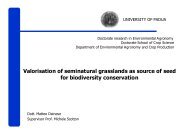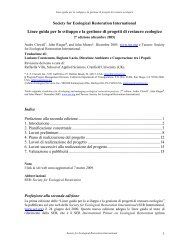THE WORLD CONFERENCE ON ECOLOGICAL RESTORATION
A Global Challenge - Society for Ecological Restoration
A Global Challenge - Society for Ecological Restoration
Create successful ePaper yourself
Turn your PDF publications into a flip-book with our unique Google optimized e-Paper software.
2005 The World Conference on Ecological Restoration 49<br />
choices between measures within a limited area. One of this is a costs-effectiveness study, showing the<br />
approach needed according to the EU Water Framework Directive. It’s concluded that there is not yet a<br />
clear policy is using decision support systems in regional water management, nor in a set of standardised<br />
instruments for preparing weighed decisions for wetland restoration.<br />
Keywords: Environmental degradation, functions of water systems, priorities and selections in measures,<br />
regional wetland restoration.<br />
Assessing the success of restoration planting in Hamilton City, New Zealand<br />
Clarkson B.D., B.D. Mackay<br />
Centre for Biodiversity and Ecology Research. University of Waikato, Private Bag 3105, Hamilton, New Zealand<br />
Hamilton City (New Zealand) is the focus of a concerted public and private effort to retrofit the City by restoring<br />
and reconstructing indigenous ecosystems. To date some 187 ha of land or 2% of the City area is being actively<br />
restored comprising 142 ha on public land and 45 ha on private land. In order to determine how successful<br />
previous restoration plantings have been in achieving desired ecosystem states and to guide future<br />
projects, research was undertaken on a range of restoration plantings within the City. Some 62 variable area<br />
plots were measured to cover the range (chronosequence) of planting ages (0-30 years), maintenance treatments<br />
(low vs high), and initial states (bare vs existing canopy) on gully slopes, the landform on which most of<br />
the restoration planting in the City occurs. Data collected from 4 plots in natural regenerating forests within or<br />
near the City were used as baselines to assess progress towards establishment of natural functioning ecosystems.<br />
Results showed that it is comparatively easy to establish a low diversity indigenous forest canopy on<br />
bared sites within 20 years, and by this stage, some early maturing canopy species will be starting to regenerate.<br />
Indigenous ferns, including tree ferns, colonize the restored stands unaided. Although restored stand<br />
basal areas are comparable with natural regenerating forests, the excessive use of well known pioneer plants<br />
and the tendency for failure of early planted mid- and later successional species leads to stalling of forest development.<br />
From 20 years on, the indigenous restoration plantings decline in indigenous species richness and<br />
cover and there is an increase in exotic species colonization especially in canopy gaps. Amongst the colonizers<br />
are several troublesome weeds (e.g., Japanese honeysuckle) with the potential to out compete indigenous<br />
species. Because of isolation and lack of seed sources, the expected mid- and late-successional shrub and tree<br />
species need to be introduced to the restored stands via enrichment planting or seeding. Most management<br />
programmes fail to recognize this requirement and valuable progress is lost. The challenge now is to build the<br />
lessons learned from this research into new and existing restoration planting programmes in the City.<br />
Keywords: urban restoration, restoration planting, forest development.<br />
Restoration of a cut-over peat bog in northern New Zealand<br />
Clarkson B.R., C.H. Watts, L.A. Schipper<br />
Landcare Research, Private Bag 3127, Hamilton, New Zealand<br />
Torehape peat bog in northern North Island, New Zealand, is currently being mined for horticultural<br />
peat. The miners are required to restore the area to original bog vegetation once the permitted depth of<br />
peat has been removed. We established a restoration trial on the mined peat surface to determine the<br />
best practical approach to restore vegetation cover. The trial involved combinations of water table, peat<br />
cultivation techniques, nutrients (N and P), and seed additions (the heath shrub Leptospermum scoparium<br />
[Myrtaceae] and the restiad Sporadanthus ferrugineus [Restionaceae]), characteristic of both early and<br />
late successional stages of bog development. The most effective treatments were raised ‘islands’ of<br />
processed peat seeded with small branches of Leptospermum laden with ripe capsules, which reached<br />
100% vegetation cover within two years. The miners adapted this approach to restore a larger area (200<br />
ha) of mined peat. We assessed the effectiveness of this upscaled approach by monitoring vegetation and<br />
invertebrate recovery at intervals following island establishment, and comparing patterns and trends<br />
with peatland buffer baselines. Results showed key peat-forming species such as Sporadanthus, Empodisma<br />
minus (Restionaceae), and occasionally, Sphagnum, had established naturally within two years,<br />
indicating the developing Leptospermum shrubland acts as a nurse for other bog plant species. As vegetation<br />
cover and species richness increase, invertebrate composition and abundance become more similar<br />
to that of the buffer. This simple low-cost approach speeds up peatland recovery and gives significant<br />
biodiversity benefits.<br />
Keywords: restoration, cut-over bog, vegetation, invertebrates, monitoring.



